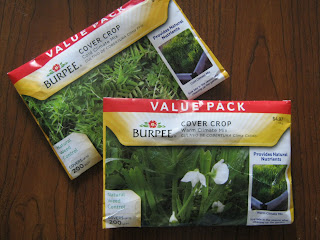When the things you need suddenly are available in appropriately-sized packages in main-stream stores, that's a clue that a lot more people have become interested in the same things.
These cost way more than I would usually pay, but I couldn't resist. This is so great!:
I found these at the Home Depot in Kennesaw, when I was just checking the seed rack to see what was there. The cool season mix contains seeds for hairy vetch and ryegrass; the warm season mix has seeds for Austrian winter peas and ryegrass. (I like how they couldn't decide which was actually good for our area, so we get both!) The packets each contain enough seed for 200 square feet of garden. With the easy-availability of these seeds, maybe more people will experiment with cover crops and find that they are a great help in the garden.
In other news - yesterday I attended a Small Scale Intensive Farming workshop, sponsored by Georgia Organics, the National Center for Appropriate Technology, and the USDA Risk Management Agency. Andy Pressman, of NCAT and a farmer who uses multiple small urban plots as his farmland, was the featured speaker.
The morning was filled with discussion of the business considerations of small-farming, and the afternoon was filled with technical considerations, including what tools are best for what purposes in very-small-scale farming enterprises like his.
Pressman's planting beds are 2 x 25 feet, and most of his "paths" are just 12 inches wide. With this tight spacing, tools need to be small and maneuverable. The biggest piece of equipment he uses is a walk-behind tractor by BCS (a European company). Everything else he showed us was hand-powered.
The seeder he demonstrated is the Earthway model that I have - I used it to plant my carrots this spring. He also brought along a whole assortment of hoes and demonstrated their correct use while talking about the benefits of each one.
While there, I met lots of great people who are all working on farming. Some are brand-new farmers, some are still in the planning stages, and some are fairly experienced. All in all, it was a great day!
Here at home, the cabbages I planted last week are doing well. I'm pretty sure they're bigger than they were when I saw them on Friday - I feel a little like one of those old ladies who exclaims to a child - "My how you've grown!"
And these are the carrots, seeded a couple of weeks ago with the seeder that my family gave me for my birthday this year:
I hope everyone else's gardens and gardening-knowledge are making as much forward progress!




















